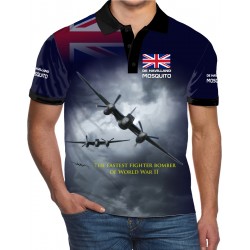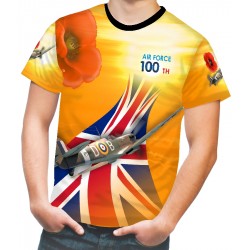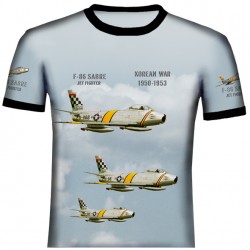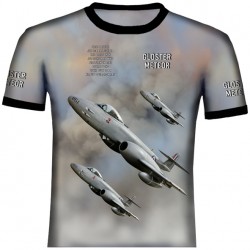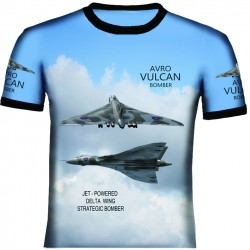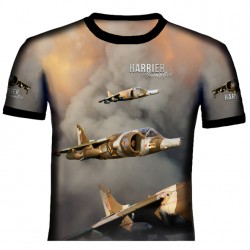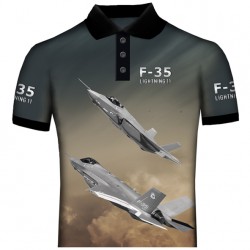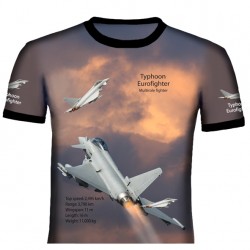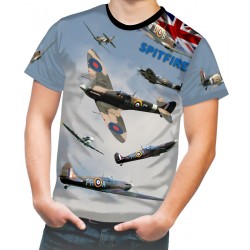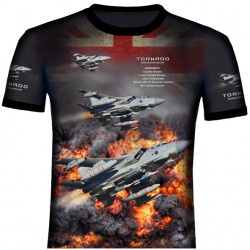-
During the Battle of Britain, from July to October 1940, the Spitfire was perceived by the public to be the main RAF fighter, though the more numerous Hawker Hurricane shouldered a greater proportion of the burden against Nazi Germany's air force, the Luftwaffe. Spitfire units, however, had a lower attrition rate and a higher victory-to-loss ratio than those flying Hurricanes because of its higher performance.
Spitfires in general were tasked with engaging Luftwaffe fighters (mainly Messerschmitt Bf 109E series aircraft which were a close match for the Spitfire)during the Battle.
-
The Eurofighter Typhoon is a highly agile aircraft, designed to be a supremely effective dogfighter in combat. Later production aircraft have been increasingly better equipped to undertake air-to-surface strike missions and to be compatible with an increasing number of different armaments and equipment, including Storm Shadow and the RAF's Brimstone.
The Typhoon had its combat debut during the 2011 military intervention in Libya with the Royal Air Force and the Italian Air Force, performing aerial reconnaissance and ground-strike missions. The type has also taken primary responsibility for air-defence duties for the majority of customer nations
-
The Gloster Meteor was the first British jet fighter and the Allies' only operational jet aircraft during the Second World War.
The Meteor's development was heavily reliant on its ground-breaking turbojet engines, pioneered by Sir Frank Whittle and his company, Power Jets Ltd.
Development of the aircraft began in 1940, although work on the engines had been under way since 1936. The Meteor first flew in 1943 and commenced operations on 27 July 1944 with No. 616 Squadron RAF. Nicknamed the "Meatbox", the Meteor was not a sophisticated aircraft in its aerodynamics, but proved to be a successful combat fighter.
Gloster's 1946 civil Meteor F.4 demonstrator G-AIDC was the first civilian-registered jet aircraft in the world
-
The Lockheed Martin F-35 Lightning II is a family of single-seat, single-engine, all-weather stealth multirole fighters. The fifth-generation combat aircraft is designed to perform ground attack and air defense missions. It has three main models: the F-35A conventional takeoff and landing (CTOL) variant, the F-35B short take-off and vertical-landing (STOVL) variant,
and the F-35C carrier-based Catapult Assisted Take-Off Barrier Arrested Recovery (CATOBAR) variant. On 31 July 2015, the United States Marines declared ready for deployment the first squadron of F-35B fighters after intensive testing. On 2 August 2016, the U.S. Air Force declared its first squadron of F-35A fighters combat-ready.
-
The Harrier, informally referred to as the Harrier Jump Jet, is a family of jet-powered attack aircraft capable of vertical/short takeoff and landing operations (V/STOL). Originally developed by UK manufacturer Hawker Siddeley in the 1960s, the Harrier emerged as the only truly successful V/STOL design of the many attempted during that era, despite being a subsonic aircraft, unlike most of its competitors. It was conceived to operate from improvised bases, such as car parks or forest clearings, without requiring large and vulnerable air bases. Later, the design was adapted for use from aircraft carriers.
-
The North American F-86 Sabre, sometimes called the Sabrejet, is a transonic jet fighter aircraft. Produced by North American Aviation,the Sabre is best known as the United States' first swept wing fighter that could counter the similarly-winged Soviet MiG-15 in high-speed dogfights over the skies of the Korean War (1950–1953).
Considered one of the best and most important fighter aircraft in that war the F-86 is also rated highly in comparison with fighters of other eras.
-
The Battle of Britain.The RAF's workhorse Hurricane Mk I and the less numerous Spitfire Mk I; Hurricane
outnumbered Spitfires in RAF Fighter Command by about 2:1 when war broke out.
The Bf 109E had a better climb rate and was up to 40 mph faster in level flight than the Rotol
(constant speed propellor) equipped Hurricane Mk I, depending on altitude.
The speed and climb disparity with the original non-Rotol Hurricane was even greater.
By the end of spring 1940, all RAF Spitfire and Hurricane fighter squadrons converted to 100
octane aviation fuel, which allowed their Merlin engines to generate significantly more power
and an approximately 30 mph increase in speed at low altitudes through the use of an Emergency
Boost Override.In September 1940, the more powerful Mk IIa series 1 Hurricanes started entering service
in small numbers. This version was capable of a maximum speed of 342 mph (550 km/h),
some 20 mph more than the original. non-Rotol) Mk I, though it was still 15 to 20 mph slower than a Bf 10
-
Well. 303 ( "Kosciuszko") Polish Fighter Squadron (Polish 303 Squadron "Warsaw them.
Tadeusza Kosciuszki") was one of 16 Polish squadrons in the Royal Air Force (RAF) during the Second World War.
It was not just the highest scoring of the Hurricane squadrons during the Battle of Britain,
but it had the highest ratio of enemy aircraft destroyed to their own lost (safest).
The squadron was named after the Polish and United States hero General Tadeusz Kosciuszko,
and the eponymous Polish 7th Air Escadrille founded by Merian C. Cooper, that served Poland
in the 1919–1921 Polish-Soviet War. No. 303 was formed in July 1940 in Blackpool, England
before deployment to RAF Northolt on 2 August as part of an agreement between the
Polish Government in Exile and the United Kingdom.
It had a distinguished combat record and was disbanded in December 1946
-
Commander Pauline Gower MBE was given the task of organising the women's section of the ATA.
The first eight women pilots were accepted into service on 1 January 1940,
initially only cleared to fly Tiger Moths from their base in Hatfield. They were:
Joan Hughes, Margaret Cunnison, Mona Friedlander, Rosemary Rees, Marion Wilberforce,
Margaret Fairweather, Gabrielle Patterson, and Winifred Crossley Fair. Overall during
World War II there were 166 women pilots, one in eight of all ATA pilots,
and they volunteered from Britain, Canada, Australia, New Zealand, South Africa,
the United States, the Netherlands and Poland. From Argentina and Chile came Maureen Dunlop
and Margot Duhalde. Fifteen of these women lost their lives in the air,
including the British pioneer aviator Amy Johnson.
-
Bomber Command crews also suffered an extremely high casualty rate: 55,573 killed out of a total of 125,000 aircrew
(a 44.4 percent death rate), a further 8,403 were wounded in action and 9,838 became prisoners of war.
This covered all Bomber Command operations including tactical support for ground operations and mining of sea lane
A Bomber Command crew member had a worse chance of survival than an infantry officer in World War I;
more people were killed serving in Bomber Command than in the Blitz, or the bombings of Hamburg or Dresden.
By comparison, the US Eighth Air Force, which flew daylight raids over Europe,
had 350,000 aircrew during the war and suffered 26,000 killed and 23,000 POWs.
Of the RAF Bomber Command personnel killed during the war, 72 percent were British, 18 percent were Canadian,
7 percent were Australian and 3 percent were New Zealanders.
-
Bomber Command crews also suffered an extremely high casualty rate: 55,573 killed out of a total of 125,000 aircrew
(a 44.4 percent death rate), a further 8,403 were wounded in action and 9,838 became prisoners of war.
This covered all Bomber Command operations including tactical support for ground operations and mining of sea lane
A Bomber Command crew member had a worse chance of survival than an infantry officer in World War I;
more people were killed serving in Bomber Command than in the Blitz, or the bombings of Hamburg or Dresden.
By comparison, the US Eighth Air Force, which flew daylight raids over Europe,
had 350,000 aircrew during the war and suffered 26,000 killed and 23,000 POWs.
Of the RAF Bomber Command personnel killed during the war, 72 percent were British, 18 percent were Canadian,
7 percent were Australian and 3 percent were New Zealanders.
-
The most famous fighter aircraft used in the Battle of Britain were the British Hawker Hurricane
and Supermarine Spitfire Mk I and theerman GMesserschmitt Bf 109 E variant (Emil) single-engined
fighters. Although the Spitfire has attracted more attention the Hurricanes were more numerous
and were responsible for most of the German losses, especially in the early part of the battle.
The turn-around time (re-arm and refuel) for the Spitfire was 26 minutes, while the Hurricane's
was 9 minutes, which increased its effectiveness
-
The Vulcan B.1 was first delivered to the RAF in 1956; deliveries of the improved Vulcan B.2 started in 1960.
The B.2 featured more powerful engines, a larger wing, an improved electrical system and electronic countermeasures (ECM);many were modified to accept the Blue Steel missile. As a part of the V-force, the Vulcan was the backbone of the United Kingdom's airborne nuclear deterrent during much of the Cold War.
Although the Vulcan was typically armed with nuclear weapons, it was capable of conventional bombing missions, a capability which was used in Operation Black Buck during the Falklands War between the United Kingdom and Argentina in 1982
-
The Bell UH-1 Iroquois (nicknamed "Huey") is a utility military helicopter powered by a single turboshaft engine, with two-blade main and tail rotors. The first member of the prolific Huey family, it was developed by Bell Helicopter to meet a United States Army's 1952 requirement for a medical evacuation and utility helicopter, and first flew in 1956. The UH-1 was the first turbine-powered helicopter to enter production in 1960 for the United States military, and more than 16,000 have been built since. The Iroquois was originally designated HU-1, hence the Huey nickname, which has remained in common use, despite the official redesignation to UH-1 in 1962. The UH-1 first saw service in combat operations during the Vietnam War, with around 7,000 helicopters deployed
-
Nicknamed the "Tonka" by the British, the Tornado made its combat debut
as part of the British contribution
to the Gulf War in 1991. Operation Granby saw nearly 60 RAF GR1s deploy to air bases
at Muharraq in Bahrain and Tabuk and Dhahran in Saudi Arabia.
Several Tornado ADVs were deployed to provide air cover,
the threat of their long range missiles being a significant deterrent to Iraqi pilots,
who would deliberately avoid combat when approached.
Early on in the conflict, the GR1s targeted military airfields across Iraq,
deploying a mixture of 450 kg (1,000 lb) unguided bombs in loft-bombing attacks
and specialised JP233 runway denial weapons. Six RAF Tornados were lost in the conflict,
four were lost while delivering unguided bombs,
-
General Dynamics F-16 Fighting Falcon is a single-engine supersonic multirole fighter aircraft originally developed by General Dynamics for the United States Air Force
-
-
-
-
-
-
-


